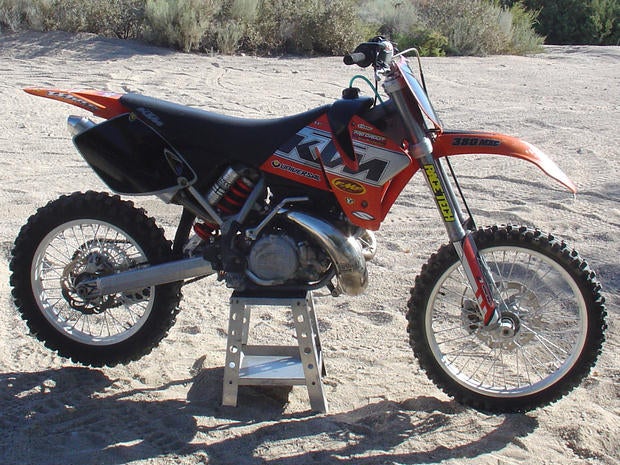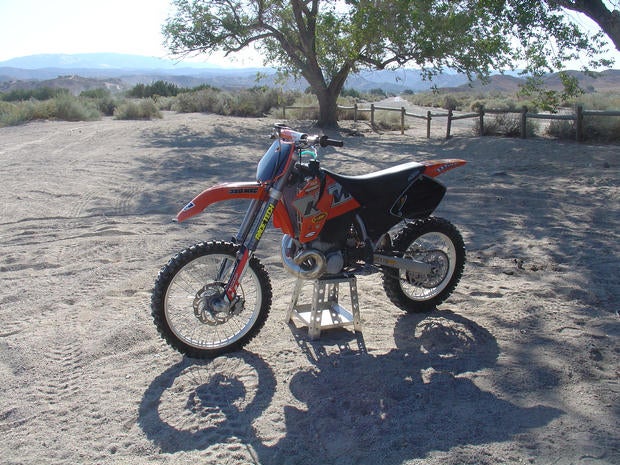Project Old School KTM 380 MXC
Revisiting the joy of owning a two-stroke
Wanting a refresher course on the joy of owning a two-stroke I decided it was time to make a purchase. Luckily the used bike market is saturated with bikes, especially two-strokes! Making my decision on what bike to buy was based on what type of riding I intended on using it for. I wanted a bike that would be nimble but be able to hold its own in the deserts of So Cal, in the sand dunes and on the occasional tight trail adventure. After riding the Off-road.com 2003 KTM 525EXC project bike for the last 5 years I have grown accustomed to having power on tap and I was not willing to give that up. Taping into my memory banks of past 2 strokes owned by myself and friends I decided why not resurrect a sleeper bike from the past, the KTM 380.
My 90s two-stroke era “regular” riding group consisted of 2 KTM 550s, 1 KTM 440, 2 KTM 380s, 1 KTM 360 and my old small-bore KTM 300. How is that for a big-bore two-stroke feast? Most of the time on these bad boys was spent riding in the deserts of Southern California but all of those big-bores also saw plenty of time on tight trails and even in the dunes. A brief run down of these gems as I recall from riding each of them. The 550 was a brute with gobs of low end and midrange power but it did not care much for revving out. The 440 was almost the opposite of the 550, not much low end but hang on for that midrange hit that just kept pulling to the moon. The 380 was a nice overall blend of decent low-end torque that flowed into a great mid-range and decent over rev. The 360 favored the midrange and top-end pull where the 300 offered fairly linear power all the way through.
Of all the 2 stroke options why the 380 you might ask? Well the 380 was offered from 1998-2002 and shares the same chassis as the 250/300 which means it is much more modern than the larger 440/550 chassis. The 380 also incorporates a power-valve which is one of the reasons it can deliver decent low end power and still rev out fairly well. At the same time it isn’t overly aggressive in its power delivery like a 250 mx bike might be. The 380 delivers its meaty power much slower than an mx style bike. In addition it is still somewhat easy to get parts for the 380, at least for the time being. Finding parts for the true 440/550 big bores is becoming a chore and when you do find them you will pay top dollar.
My target years for a 380 were in the 2000-2002 time-frame because during those years the bikes came with the newer and lighter upside forks as well as the higher-output ignition that would support the future addition of lighting quite well. After scanning the internet for a few months I came across a fairly clean 2000 380MXC. The MXC means it has a close ratio transmission which allows the bike to pull from gear to gear and stay right in the meat of the power. The fact that I intend to use this bike for the open desert with sand washes and hill climbs as well as at the dunes makes the MXC tranny a good choice. From the ad it appeared the bike was mostly stock with the exception of a Pro-Circuit Platinum pipe and a FMF Q spark arrestor. Even the chain and sprockets looked to be stock, overall a good sign.

I went ahead and purchased the bike knowing that it was already eight years old and I was going to have go through it to make sure it is reliable. For a baseline I wanted to ride the bike to get a feel for its current power and suspension before doing some freshening up of things. Once in the garage I did a general pre-ride inspection of the bike and immediately found the rear-axle nut loose. The previous owner had put on a new tire and probably forgot to tighten it. Everything else seemed ok and the bike was ready for its maiden voyage.
I headed out locally to Gorman in So Cal to do a shake down ride in Hungry Valley. The valley trails have a mix of flat and hilly terrain consisting mainly of hard packed dirt with loose rocks along with a few sand washes. After a high traffic summer of bikes and quads all the valley trails are generally dry, choppy and beat up. If I was looking for traction and smooth trails I wasn’t going to find it here but it would be a good place to let the 380 loose for a while.
I fired up the 380 and headed out onto Backbone trail. Backbone trail winds it way up and down along a ridgeline for a few miles before dropping back into the valley. Right away the 380 was lofting its front wheel coming out of the turns and heading down the straights. A little more throttle control was definitely a necessity over riding the 525 on the same trail. The 525 is no slouch but on the 380 things just happen quicker. While the carburetion felt a little rich from ¼ throttle and into the midrange the bike had no trouble revving out when the trail opened up a bit. Upon decelerating into the corners I noticed the bike was surging a bit, a possible sign of a lean pilot and/or misadjusted air screw.
Knowing a little about my friends’ old 380s finicky jetting needs should help me get this bike ironed out in the jetting department. The 380s are known for being somewhat hard to jet in stock form. If you try and richen up the pilot to get rid of the surging then you can run into fouling plugs because the ¼- midrange is already on the blubbery side and you begin compounding the problem. The formula for success on one of my buddies 380 was to get the cylinder head reshaped for cleaner burning which resulted in bike that responded much better to jetting changes. Reshaping the head requires a professional machinist or at least someone with the tools and know how to do the job, neither of which I was able to find just standing around at Gorman that day.
Once off of Backbone trail and onto the valley floor I was able to get into a sand wash and really open up the 380. It really pulls with authority from the midrange through the top-end. The 300 my buddy was riding felt more like a 200 compared to the 380. The 380 has much more low end and midrange power over the 300. Gearing wise the 380 won’t reach the same top-speed as my 525 because it is a 5 speed over the 525s 6 speed wide-ration transmission. In the sand washes the 380 seems to just jump right to the top of the sand and float along instead of sinking in like my 525 tends to do.
Overall I was very happy with the power despite the obvious need for jetting changes but what about the handling? The suspension on the bike was apparently setup by Dicks Racing for around a 220 pound rider, well over my 180 pound riding weight. The spring rates on both the fork and shock are too stiff for me which prevented the bike from wanting to settle into the corners. Despite this fact the valving on both ends felt very controlled and balanced, responding equally well to whoops and trail chop. One of the future changes with the suspension will at a minimum need to be a change to lighter springs.
So far the 380 has not disappointed and getting back on a semi-big bore two-stroke has brought back some great memories. The power delivery and excitement of the 380 two-stroke can’t be matched by any four-stroke that I have ridden to date. I am already looking forward to getting some desert seat time in on the bike to see what it can do. Before that happens however I want to make sure the bike is reliable. Stay tuned as I continue with articles covering my progress of going through the bike, checking and rebuilding anything that looks suspect and then getting it dialed in.



 Your Privacy Choices
Your Privacy Choices